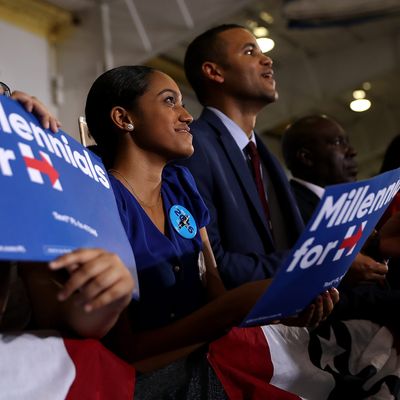
One month ago, it looked like American democracy was on the cusp of joining the McWrap, the bar of soap, and human relationships on the long list of things that millennials had “killed.” One nationwide poll released in mid-September found 44 percent of voters under 35 opting for a third party. A series of other state and national surveys put that figure between 25 and 30 percent — more than enough to flip (what was then) an increasingly close race.
Suddenly, it seemed that the true cost of all those participation trophies and degrees in trigger-warning studies was a generation so narcissistic and entitled, it saw a potential pseudo-fascist takeover of the United States as an acceptable price for its right to express its true self in the ballot box.
Many liberal pundits had never hated millennials more. Others insisted the true villain here was the pied piper of Burlington, who had marched into the Democrat tent only to lead its young people astray. A few even argued that the only way Hillary Clinton could possibly win back these hedonistic post-adolescents was to make it easier for them to smoke their marijuana cigarettes. (And one or two noted that, if only millennials voted, there would be a zero percent chance of a Trump presidency).
These columns have aged about as well as Donald Trump’s campaign: After commanding little more than 40 percent of the youth vote for much of her general-election run, Clinton is now on pace to match the 60 percent share Obama won in 2012, according to an enormous new study from the Black Youth Project at the University of Chicago.
And, as Vox’s Jeff Stein notes, the evidence for Clinton’s resurgence with young voters extends far beyond one survey. A new Rock the Vote/IPSOS/USA Today poll also shows Clinton hitting the 60 percent mark, while Morning Consult’s tracking poll shows the Democratic nominee gaining 11 points with younger voters over the past month. Notably, Clinton’s gains among the young are much larger than the boost she’s gotten from other demographics in the weeks since Trump began drowning in a wave of sexual-assault allegations — in Morning Consult’s poll, Clinton’s overall lead has increased by only 2 points in October
What, then, explains Clinton’s sudden consolidation of the left-leaning youth vote? The short answer appears to be that, in recent weeks, millennials finally got a clear picture of the options before them. And the more young liberals listened to Gary Johnson, the more they realized they didn’t actually care enough about legal weed to vote for a guy who doesn’t think the government should regulate carbon emissions or campaign finance — or that presidential candidates should be expected to know who or what “Aleppo” and “Harriet Tubman” are. And, sure, Jill Stein had some appealing policy ideas. But so do a lot of other people who will never be president.
Meanwhile, the Clinton-Trump debates did a better job of dispelling the idea that there was no significant difference between the major-party nominees than a thousand hectoring blog posts ever could.
“Over time, young voters have really come to think that Gary Johnson doesn’t represent their interests, that Jill Stein is not going to win, and that the stakes are very high in this election,” Cathy Cohen, a political scientist at the University of Chicago and lead author of the GenForward study, told Vox.
Harvard political scientist John Della Volpe, who studies youth voting patterns, told the site that a “significant number” of young people hadn’t seen Clinton in a “long format” until the first presidential debate, when “an overwhelming majority of millennials saw her with fresh eyes — and, generally speaking, they liked what they saw.”
Still, while younger voters appear primed to show up in similar numbers for Clinton as they did for Obama, they don’t, in the aggregate, see her in nearly as positive a light. The youngest members of Generation Y still view Clinton — and her party — with more skepticism than do voters even a few years their senior.
In a race against a less grotesquely unappealing Republican — and/or more competent and compelling third-party candidates — these voters may prove more difficult to corral. Increasing younger millennials’ identification with, and enthusiasm for, the Democratic Party should be a central concern for Team Blue going forward. There’s no guarantee that come 2020 these youngsters will “Pokémon Go” back to the polls.






























